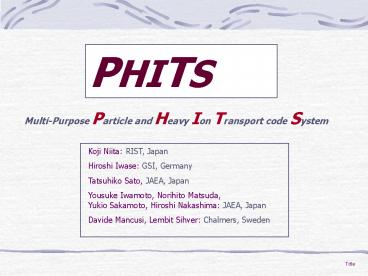PHITS (Particle and Heavy Ion Transport code System) - PowerPoint PPT Presentation
1 / 17
Title:
PHITS (Particle and Heavy Ion Transport code System)
Description:
Title: PHITS (Particle and Heavy Ion Transport code System) Author: koji Last modified by: niita Created Date: 11/19/2003 12:05:29 AM Document presentation format – PowerPoint PPT presentation
Number of Views:148
Avg rating:3.0/5.0
Title: PHITS (Particle and Heavy Ion Transport code System)
1
Title
PHITS
Multi-Purpose Particle and Heavy Ion Transport
code System
2
Overview (1)
Overview of PHITS (Particle and Heavy Ion
Transport code System) (1)
External Field Magnetic Field, Gravity
Optical and Mechanical
devices
3
Overview of PHITS (Particle and Heavy Ion
Transport code System) (2)
photons electrons
hadrons
neutrons
protons
nucleus
200 GeV
200 GeV
200 GeV
100 GeV/u
100 GeV
? JAM, Hadron cascade model ?
JQMD
In progress
? GEM, Evaporation
process ?
1 GeV
? SPAR, ATIMA, Ionization process ?
20 MeV
10 MeV/u
1 MeV
1 MeV
only transport with dE/dx (SPAR, ATIMA)
1 keV
0 MeV
0 MeV/u
thermal
0 MeV
4
JAM
JAM code for Hadron Nucleus Collisions up to 200
GeV
Introducing JAM (Jet AA Microscopic Transport
Model) Y. Nara et.al. Phys. Rev. C61 (2000)
024901 JAM is a Hadronic Cascade Model, which
explicitly treats all established hadronic states
including resonances with explicit spin and
isospin as well as their anti-particles. We have
parameterized all Hadron-Hadron Cross Sections,
based on Resonance Model and String Model by
fitting the available experimental data.
AuAu 200GeV/u in cm
5
JAM (1)
DDX of elementary process, p(12GeV/c) p ,
by JAM
JAM Y. Nara et.al. Phys. Rev. C61 (2000) 024901
rapidity distribution
transverse momentum distribution
Data Nucl. Phys. B69 (1974) 454
6
JQMD-1
JQMD code for Nucleus-Nucleus Collisions up to
100 GeV/u
JQMD (Jaeri Quantum Molecular Dynamics) for
Simulation of Nucleus-Nucleus Collisions
K. Niiita et.al. Phys. Rev. C52 (1995) 2620
http//hadron31.tokai.jaeri.go.jp/jqmd/
56Fe 800 MeV/u on 208Pb
Analysis of Nucleus-Nucleus Collisions by JQMD
7
JQMD-2
JQMD code in PHITS
Introducing JQMD in PHITS H. Iwase et.al. J.
Nucl. Sci.Technol. 39 (2002) 1142
Neutron Spectra from Thick Target
8
New Feature (1)
Event Generator Mode of PHITS
What are we doing in Monte Carlo calculations for
particle transport ?
- Solving one-body Boltzmann equation
- by using the evaluated nuclear data.
- MCNP type code
energy is conserved in average. no correlations
- Simulating real phenomena
- by using event generators.
- PHITS for high energy by JAM, JQMD.
treat all ejectiles of collisions. energy and
momentum are conserved in each collision.
Observables beyond one-body quantities are often
required.
Deposit energy distribution in a cell (pulse
height tally). LET distribution in a micro
dosimetry, Coincident experiments,































